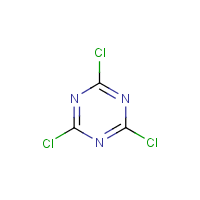Cyanuric chloride
Agent Name
Cyanuric chloride
CAS Number
108-77-0
Formula
C3-Cl3-N3
Major Category
Toxic Gases & Vapors

Synonyms
1,3,5-Triazine, 2,4,6-trichloro-; 1,3,5-Trichlorotriazine; 2,4,6-Trichloro-1,3,5-triazine; 2,4,6-Trichloro-s-triazine; 2,4,6-Trichlorotriazine; Chlorotriazine; Cyanur chloride; Cyanurchloride; Cyanuric acid chloride; Cyanuric acid trichloride; Cyanuric trichloride; Cyanuryl chloride; Kyanurchlorid [Czech]; Trichloro-s-triazine; Trichlorocyanidine; Tricholorotriazine; Tricyanogen chloride; s-Triazine trichloride; s-Triazine, 2,4,6-trichloro-; sym-Trichlorotriazine; syn-Trichlotriazin [Czech]; [ChemIDplus] UN2670
Category
Other Toxic Gases & Vapors
Description
Colorless crystals with pungent odor; [ICSC] White powder; [MSDSonline]
Sources/Uses
Used to make s-triazine herbicides, insecticides, triallyl cyanurate, polyesters, optical brighteners, other dyes, plastics, pharmaceuticals, explosives, and surfactants; [HSDB] Used as a coupling agent for nucleic acids and proteins; Also used in cyanuric chloride-activated paper for capillary and electroblotting applications; [Merck Index]
Comments
A severe skin, eye, and respiratory tract irritant; May cause pulmonary edema; May cause skin sensitization and asthma after prolonged contact; [ICSC] Toxic by ingestion and inhalation; [Hawley] Lachrymator; [CHEMINFO] Causes burns; Harmful if swallowed; Very toxic by inhalation; Reacts violently with water; May cause skin sensitization; [MSDSonline]
Biomedical References
Exposure Assessment
MAK
0.0076 mg/m3
Vapor Pressure
0.023 mm Hg
Lethal Concentration
LC50 (mice) = 10 mg/m3/2h
Explanatory Notes
VP from ChemIDplus;
Adverse Effects
Skin Sensitizer
Yes
Lachrymator
Yes
Toxic Pneumonitis
Yes
Dermatotoxin
Skin burns
Diseases, Processes, and Activities Linked to This Agent
Diseases
Occupational diseases associated with exposure to this agent: